A simple left turn whilst learning to drive or during a driving test can have many potential hazards, from tight turnings, badly parked cars, or cyclists and pedestrians that could be crossing your path.
The driving test will of course involve many left turns on a variety of different roads. It’s important that the correct rules are taken, not only for safety reasons, but to successful pass the driving test.
This tutorial explains the correct procedure for making left turns along with road signs that may be encountered and the potential hazards that any driver may experience.
Locating a left turn
Locating a left turn at the earliest opportunity will provide you with much more time to prepare for the turn and to perform it safely.
Keep a an eye on left turn ahead warning signs, if a sign isn’t present however, look for gaps in trees, houses, hedges or parked cars that may suggest a left turn is ahead.
Left turn rules for the driving test
During the driving test, the examiner will be expecting you to follow the correct rules and procedure for making left turns. The learner driver must follow the MSPSL (Mirror, Signal, Position, Speed and Look) procedure. Starting from the bottom of the diagram, this procedure is as follows:
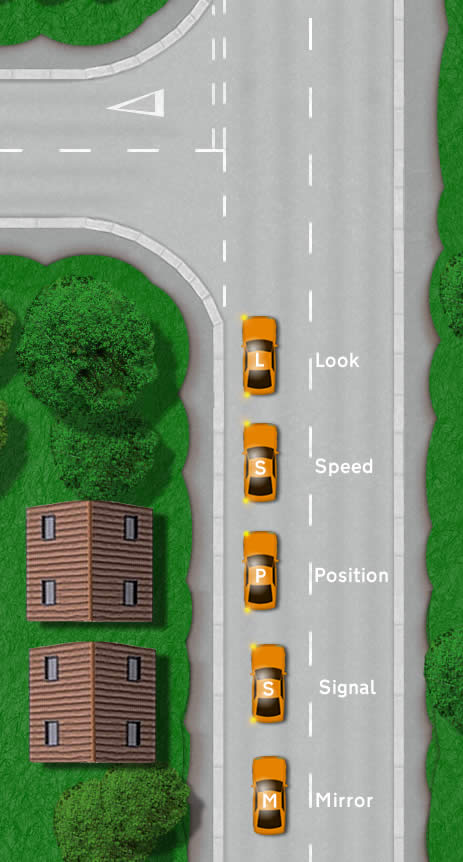
-
Mirror
Once you have located the left turn up ahead, look into the interior mirror, followed by the left door mirror.
-
Signal
You will need to signal to the left just after checking the mirrors.
-
Position
The position of your car depends on the width of the left turn and the width of the road you are currently on. If the width of the left turn you intend on taking is narrow, you may need to position your car further to the right before taking the turn. This will allow for a wider turning angle and avoid hitting the kerb or mounting the pavement.
If the road you are currently on before taking the left turn is reasonably wide and the left turn is reasonably wide, position the car to the left side of the road.
-
Speed
Left turns are usually taken in 2nd gear at around 10-15 mph. If the left turn is very narrow and closed, 1st gear at around 5 mph may be required.
-
Look
Before taking the left turn, a final check in the left mirror is required and possibly the left blind spot in case of cyclists.
For a more in depth look into the this routine, see:
Left turn hazards
Just before making the final left turn, check the left mirror and if unsure, also check the left blind spot for cyclists, especially in busy areas. See image for example.
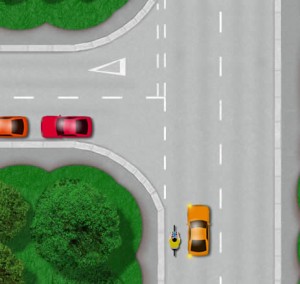
Prepare for any hazards upon taking the turn such as pedestrians crossing the road just as you are about to turn and cars parked closely to the junction. Just like T-junctions, a left turn can be closed and difficult to see what is around the turn.
Accidents can easily happen if you are not well prepared. As the driver, you should always give way to cyclists and pedestrians crossing the road, even if it means stopping in an inappropriate area.
Closed and open left turns
Try to establish as early as possible if the left turn is closed (blind) or open (clear). See images above for an example. Accidents can frequently happen when drivers make a left turn that is closed and they are driving too fast or under-prepared for any hazards. A closed left turn can be difficult to see around due to trees, hedges or fences.
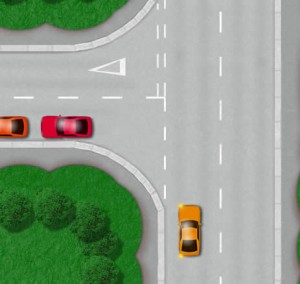
If the left turn is closed and narrow, you will be required to slow the car down to an appropriate speed and gear. This is often 1st gear and around 5 mph before taking the turn.
Observation is important as you approach the left turn. You must use the appropriate gear and speed, but you must also prepare to give way to pedestrians, cyclists and hold back due to parked cars near the junction.
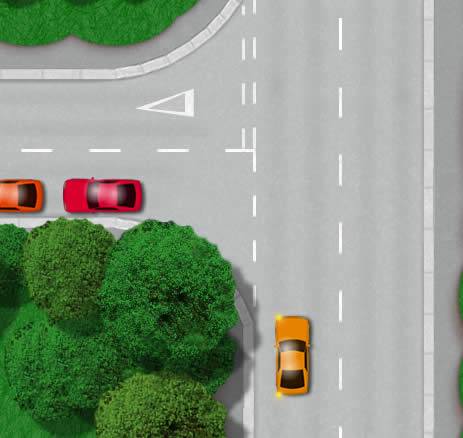
If the left turn is narrow, you will need to take a wider turning angle (keeping further to the right before making the turn). This will avoid you hitting the kerb and entering the left turn on the wrong side of the road.
Making a left turn tips
- Try to locate the turn as soon as possible by use of signs, road markings or gaps in trees and houses.
- Use the MSPSL (Mirror, Signal, Position, Speed and Look) routine on the driving test.
- Establish if the left turn is open or closed so as to decide an appropriate speed and gear for making the turn.
- Take a final check of the left mirror before making the turn in case of cyclists.
- If the turn is narrow, take it wide so as to avoid hitting the kerb, mounting the pavement and you must try to avoid entering the left turn on the wrong side of the road.
Left turn signs
Left turns are often signified by the use of road signs such as below. During a driving test, keep a keen eye on all road signs. Making a left turn into a restricted area will often a no left turn sign before.
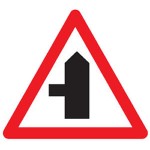
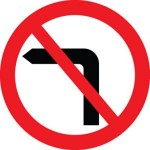
It is possible that a driving examiner may ask you to ‘take the next available left’ during a driving test. The next junction may in fact be a no entry and have a no left turn sign before. Making this turn is illegal and will certainly fail a driving test.
Arm signal to turn left
Occasionally indicator or brake lights may fail or you may feel that other road users may benefit from a arm signal.
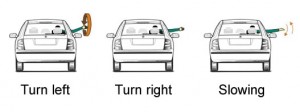

Hi I have been reading your tutorials. One of the best websites. I am learning to drive automatic cars. My left and right turns are very bad mainly while coming out from Major road to minor road. My hand and foot coordination are not sitting properly. Could you please give me some advice as to how much to turn the steering wheel and at what speed while doing left and right turn. I keep on turning and the instructor has to tell me everytime enough turning. I do not get the judgment correct.
Regards
Hello Priya, glad you have found the website useful.
Unfortunately I cannot tell you how much to turn the wheel and at what speed simply because each and every turn is different. What this is, is an issue with spatial awareness (where the car is in relation to the road) and it can be linked to conditions such as dyspraxia. The only way to overcome this is by repetition and making left / right turns over and over again.
Your instructor needs to find a quiet location with plenty of left and right turns where you can practice with as few hazards and distractions as possible. Help yourself by using reference points, so for example stop on your side of the road (straight road) in a normal driving position. Look where the kerb comes down the road into the windscreen and ‘hits’ the dashboard. Where ever it comes into the dashboard is a reference point. As you round a corner, this same reference point will begin to appear again and as it does, straighten the wheel. Other reference points are views you get in your left mirror; where the kerb is parallel to the car. As you round the corner, when it looks parallel, straighten the wheel.
The instructor should prompt you by using increments of turns, such as quarter turn of the wheel, half turn, one turn and full lock (left/right). Keep doing this over and over, starting off at slow speeds and gradually increase your speed. After some practice you’ll be doing it without the need of reference points.
Thank you for your advise. Can I find some more advise on this topic on any websites? Also is there any way spatial aware ness can be increased other than practice?. Whether other people also have this kind of issue or only me?Regards, Priya.
Hi Priya,
It’s not just you; I’ve experienced other learner drivers on many occasions with this. There are plenty of resources online and exercises, but I’ve only dealt with the learning to drive aspects of this.
Hi
Please could you help with the below 2 queries
The first query is when driving how do you judge the left side of your car when passing parked vehicles? When passing parked vehicles I always get nervous that the left front of the car might hit the parked car and my instructor pulls my steering wheel to avoid hitting.
The second query is while doing reverse or forward bay parking how to judge whether the car front is straight. I find it difficult to judge whether the front of the car is straight? Could you please give some tips to this
Thank you for your help.
Regards
Priya
Hi Priya
For passing parked cars that are on the left, you first need to practice this with the kerb – which is one of the first things you do anyway. When parking on the left, you can use your left mirror to see the distance you are from the kerb and if it looks parallel, and you can also use a reference marker placed in the windscreen. See pulling up on the left for an example of this. Now practice the same, except driving and stopping 1 metre away from the kerb, you’ll need to alter the reference points. This is approx the distance you should be from parked cars when driving (in an idea situation). Do this on a quiet, straight road and it will help with judging distance from parked cars.
The second point for bay parking also relates to kerb parking. You will know that your car is in the bay and straight by looking in your side mirrors and at the lines of the bays. When you park up on the left and look into your left mirror and see the kerb parallel with the car, instead look for the bay line. Use everything around you as reference points. You can tell when you’re far enough into the bay (not sticking out) if you use the end of the bay lines. With the help of your instructor, make a good bay park, then look at the end of the bay lines and where they line up with your car, usually with the door mirrors. Use that as a reference – see bay parking and bay parking reference points. It’s all about making use of everything around you to understand where you are in relation to it.
Thank you
When turning left from a minor road into a main road via a very short filter lane, after entering the filter lane,do I mirror, signal, then pull out when the traffic is not approaching from my right, or stop in the filter first, wait for a clear road I.e. no traffic approaching from my right then mirror, signal and then pull out.
Is it correct to stop in the very short filter lane?
Hi Roger,
You must legally stop at a junction if there’s a stop sign or if it’s controlled by traffic lights and the light is red. Anything else comes down to the ‘give way’ rule.
In terms of dedicated / filter lanes, if the lane is reasonably long, there’s usually no need to indicate at all because other road users know where you’re going (though you should indicate if there’s any reason why this might be unclear or if you might think it will help other drivers understand your intentions).
If in your words, the filter lane is ‘very short’, then it would be best to treat this junction as you would any other junction that does not have a filter lane. In other words, mirror, signal in good time (before you enter the filter lane if it’s particularly short), then decide whether you need to stop at the junction line based on what you can see and whether it’s clear to continue without stopping.
Hello
What a fantastic website.
I gave a dreadful problem with sharp left turns and was wondering if there’s an essential “ingredient” that I could add to enable a breakthrough please. I can get the co-ordination on kinder turns and I understand when you speak about adopting a better road position prior to turning but what about actually making the turn please? Do Ieave the steering just a little later? It all gets a bit confusing and then panic mode sets in. Any feedback would be greatly appreciated. Thankyou
Hi Tina,
When it comes to sharp left turns, think of it as driving into a bay on your left at a supermarket. The road position on a sharp left turn is particularly important. Just as with driving into a bay, you will need to position your car to the right-side of your lane just prior to making the turn. This will make the turning angle wider, therefore making the turn easier and less chance of clipping the kerb or entering the left turn on the wrong side of the road. You’ll also need to take the turn much slower compared to normal left turns – think along the lines of around 5 mph or so (particularly if the road you’re going into is quite narrow.
In terms of steering, again think of driving into a bay again. Keep very slow, position your car then yes, you would leave the steering a little later than normal, but you will need to steer much faster than a typical left turn.
As I say, think of it as driving into a bay on your left. If you’ve not done much of that, then doing so will help you with those sharp left turns.
Thankyou so much, that is really helpful and greatly appreciated.
Hi Again
I’ve just re-read your reply, a little slower this and would like to say thanks once more. This is because you have answered my question fully and in good detail. Its exactly what I wanted to know. Previously, on other site,I’ve just been advised on MSPSL (the easy bit) and not the actual “technique”, so as soon as I have my next lesson I will be trying this!
Glad to have helped Tina
Hi, I got my license around 5 years ago but have only just purchased a car and started driving so I’m having to regain my confidence and relearn some of the little rules. This website has been a huge help! I’ve found that my driving overall is fine and I have no issues with gear changing at higher speeds. One thing I’m struggling with though, is getting the speed and gear right when turning left/right. I find that when driving down the road in 3rd or 4th gear I’m having trouble with slowing down to a speed that is appropriate for 2nd gear and this causes my car to shudder as though it’s going to stall. I’ve found that this happens when I slow down using the distances noted above, the only time it doesn’t happen is if I slow down sooner but this seems to be frustrating for other drivers as I’m driving too slow. Any tips?
Hi Tasha,
Does your car shudder only when braking or does it do it while decelerating only? Most modern cars are quite flexible in terms of gears and speed. You should really be able to be in 5th gear at 40 mph, slow to 10 / 15 mph and go directly into 2nd gear without any shuddering. To prevent the shuddering, you may need to slow down by going down through all the gears (sequential gear changing rather than block gear changing). If it still shudders, it may possibly be a characteristic of your car, but it could also be a fault. If it shudders only when braking, it may be an issue with your brakes. If it does it when you’re not braking, it may be another issue such as your transmission.
Hi,
I am a learner and my instructor has picked up on my left turns being too wide or I clip the verge. I am anxious that I get this right as soon as possible before it becomes a habit.
Hi Diane,
When making turns, it’s difficult to assign a specific technique to help avoid hitting kerbs or going too wide because left turns vary so much. But I can assure you that there’s no need to be anxious about it because with practice, you’ll get there. When learning to drive, everybody has their particular areas that they struggle with and the only way round it is to keep doing it until you get it right. Keep practicing, making lots of left turns, try not to get annoyed or anxious as this will set you back. Then, all of a sudden, you’ll start getting it right, everybody does and so will you.
If there are 2 left turns within 10m of each other (the first into a house, the second from a major to a minor road, is it better to go through the sequence well in advance of the 2nd left turn you are making or should you wait until parallel with the first left turn before indicating which is only 10m from the turn you are making
Hi Mat,
I’d recommend running through the MSM routine well in advance of the 2nd left turn. Being as it’s a private driveway, there shouldn’t be any confusion and it might be hazardous leaving it too late.